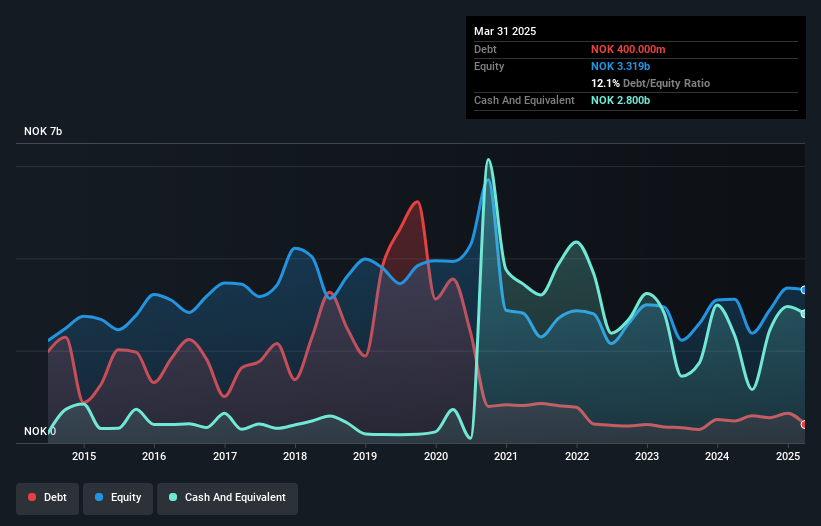Legendary fund manager Li Lu (who Charlie Munger backed) once said, 'The biggest investment risk is not the volatility of prices, but whether you will suffer a permanent loss of capital.' So it might be obvious that you need to consider debt, when you think about how risky any given stock is, because too much debt can sink a company. We can see that Veidekke ASA (OB:VEI) does use debt in its business. But the real question is whether this debt is making the company risky.
We've discovered 1 warning sign about Veidekke. View them for free.When Is Debt Dangerous?
Debt assists a business until the business has trouble paying it off, either with new capital or with free cash flow. If things get really bad, the lenders can take control of the business. However, a more frequent (but still costly) occurrence is where a company must issue shares at bargain-basement prices, permanently diluting shareholders, just to shore up its balance sheet. Of course, debt can be an important tool in businesses, particularly capital heavy businesses. When we think about a company's use of debt, we first look at cash and debt together.
How Much Debt Does Veidekke Carry?
You can click the graphic below for the historical numbers, but it shows that Veidekke had kr400.0m of debt in March 2025, down from kr479.0m, one year before. However, it does have kr2.80b in cash offsetting this, leading to net cash of kr2.40b.

How Strong Is Veidekke's Balance Sheet?
We can see from the most recent balance sheet that Veidekke had liabilities of kr12.1b falling due within a year, and liabilities of kr2.76b due beyond that. Offsetting this, it had kr2.80b in cash and kr6.08b in receivables that were due within 12 months. So its liabilities outweigh the sum of its cash and (near-term) receivables by kr5.97b.
This deficit isn't so bad because Veidekke is worth kr20.8b, and thus could probably raise enough capital to shore up its balance sheet, if the need arose. But it's clear that we should definitely closely examine whether it can manage its debt without dilution. Despite its noteworthy liabilities, Veidekke boasts net cash, so it's fair to say it does not have a heavy debt load!
Check out our latest analysis for Veidekke
While Veidekke doesn't seem to have gained much on the EBIT line, at least earnings remain stable for now. The balance sheet is clearly the area to focus on when you are analysing debt. But ultimately the future profitability of the business will decide if Veidekke can strengthen its balance sheet over time. So if you want to see what the professionals think, you might find this free report on analyst profit forecasts to be interesting.
Finally, while the tax-man may adore accounting profits, lenders only accept cold hard cash. While Veidekke has net cash on its balance sheet, it's still worth taking a look at its ability to convert earnings before interest and tax (EBIT) to free cash flow, to help us understand how quickly it is building (or eroding) that cash balance. Over the last three years, Veidekke actually produced more free cash flow than EBIT. That sort of strong cash generation warms our hearts like a puppy in a bumblebee suit.
Summing Up
Although Veidekke's balance sheet isn't particularly strong, due to the total liabilities, it is clearly positive to see that it has net cash of kr2.40b. And it impressed us with free cash flow of kr2.3b, being 102% of its EBIT. So is Veidekke's debt a risk? It doesn't seem so to us. There's no doubt that we learn most about debt from the balance sheet. But ultimately, every company can contain risks that exist outside of the balance sheet. To that end, you should be aware of the 1 warning sign we've spotted with Veidekke .
At the end of the day, it's often better to focus on companies that are free from net debt. You can access our special list of such companies (all with a track record of profit growth). It's free.
New: Manage All Your Stock Portfolios in One Place
We've created the ultimate portfolio companion for stock investors, and it's free.
• Connect an unlimited number of Portfolios and see your total in one currency
• Be alerted to new Warning Signs or Risks via email or mobile
• Track the Fair Value of your stocks
Have feedback on this article? Concerned about the content? Get in touch with us directly. Alternatively, email editorial-team (at) simplywallst.com.
This article by Simply Wall St is general in nature. We provide commentary based on historical data and analyst forecasts only using an unbiased methodology and our articles are not intended to be financial advice. It does not constitute a recommendation to buy or sell any stock, and does not take account of your objectives, or your financial situation. We aim to bring you long-term focused analysis driven by fundamental data. Note that our analysis may not factor in the latest price-sensitive company announcements or qualitative material. Simply Wall St has no position in any stocks mentioned.
About OB:VEI
Veidekke
Operates as a construction and property development company in Norway, Sweden, and Denmark.
Excellent balance sheet with proven track record.
Similar Companies
Market Insights
Community Narratives




